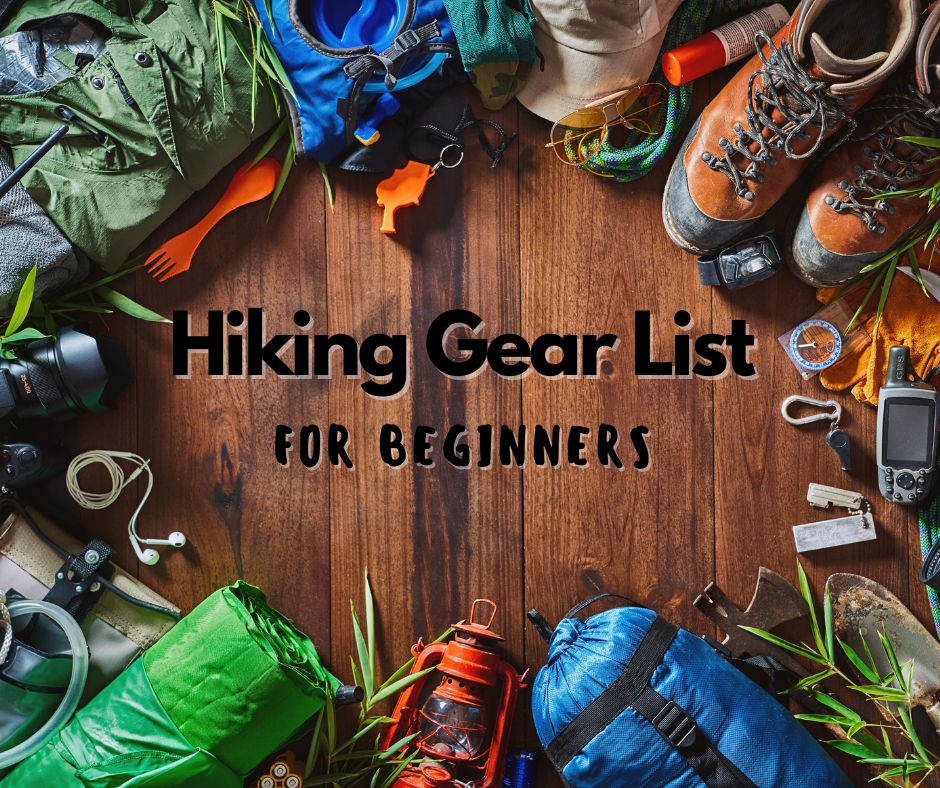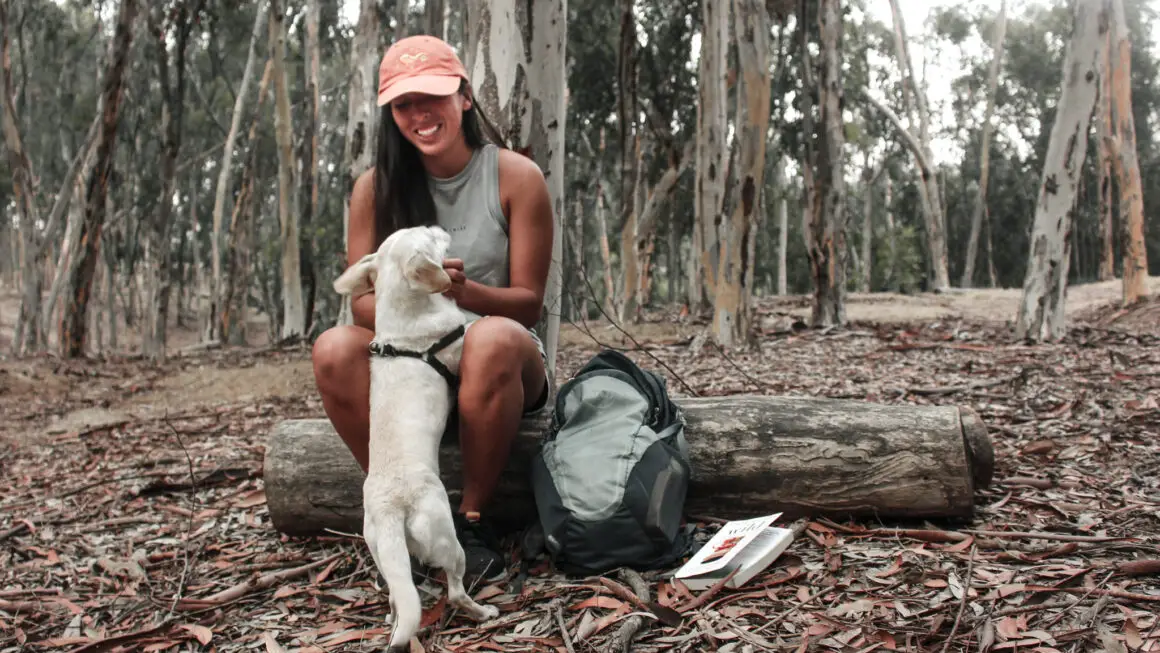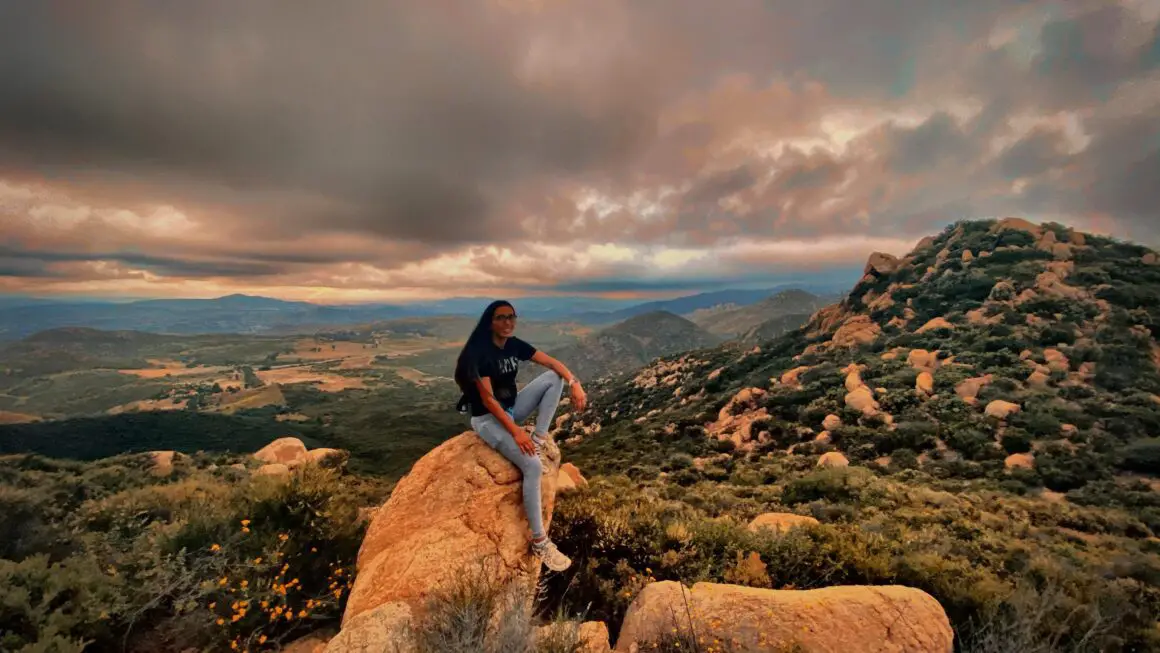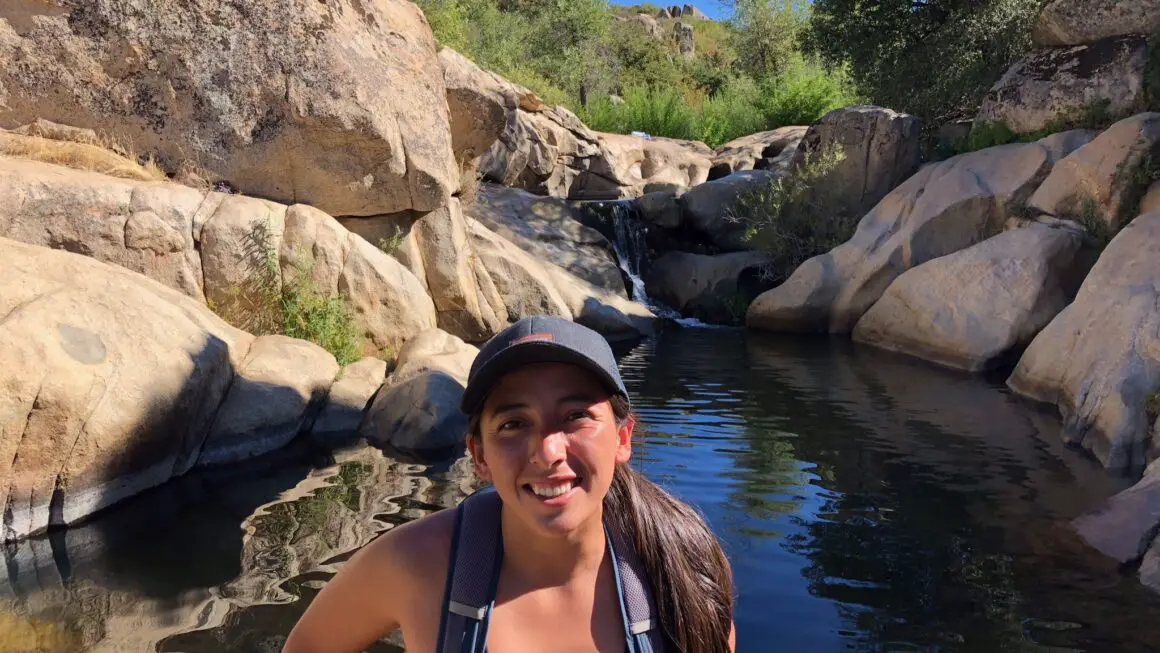This post will give you a full hiking gear list for beginners. I’ve hiked countless miles all over San Diego and summited Mt Whitney in 2021. I speak from experience when I provide gear recommendations. This post will discuss what gear to pack, what to wear, and what to have in case of an emergency if you’re a beginner hiker.
In general, the hiking gear you need is highly dependent on the length/ difficulty of the hike and the weather. There are some common items you’ll need for any hike.
Table of Contents
Hiking Gear List for Beginners
Depending on where you’re hiking and the season you might need additional gear, like snow shoes or crampons. The majority of beginner hikers aren’t hiking in those conditions. The Hiking Gear List for Beginners (below) gives you a good idea of the basic gear you need for your average day hike in ideal weather conditions.
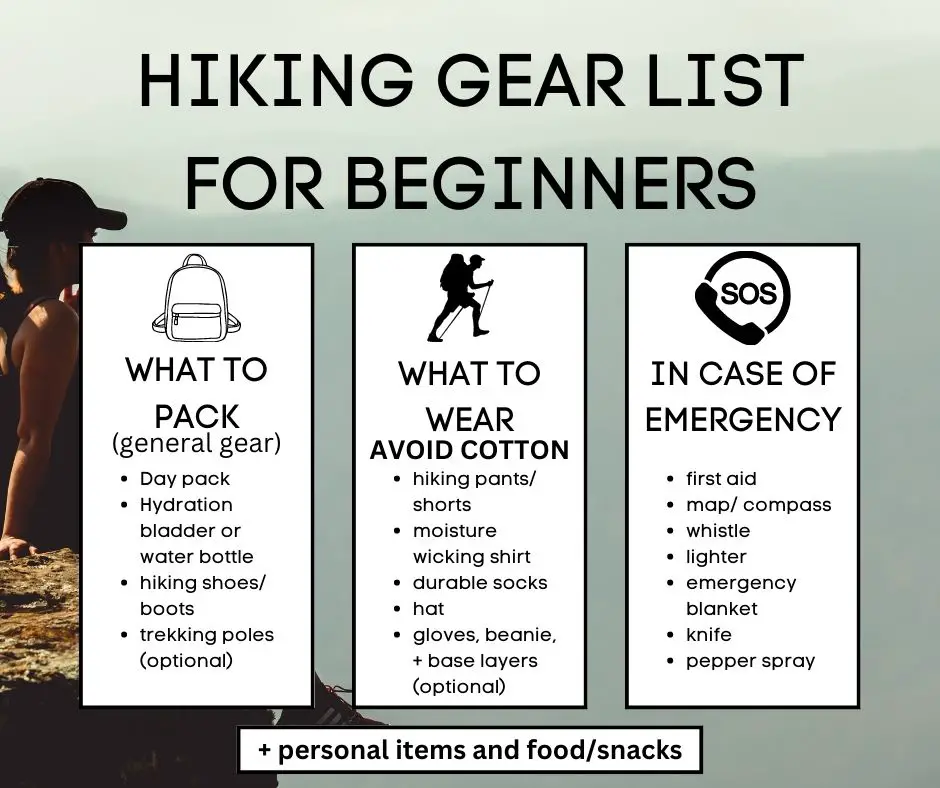
What to Pack
When I first started hiking in 2015, all I really needed was a water bottle, a decent pair of shoes, a map, granola bar, and some sun protection. I could fit all of my gear in a little cinch pack and off I went. I would wear what I wore to the gym- running shorts/ leggings, t-shirt, and my running shoes.
This only lasted me so long! The more I hiked, the more I realized I needed better quality gear even though I was still a beginner. There’s hiking equipment and clothes that are better designed for the activity to minimize injury and make it a more comfortable experience overall.
If you’re a beginner hiker looking to upgrade your gear, here’s what gear I would recommend you upgrade sooner rather than later: hiking shoes/ boots, hiking daypack, and lastly your hiking clothes.
Daypack for Beginners
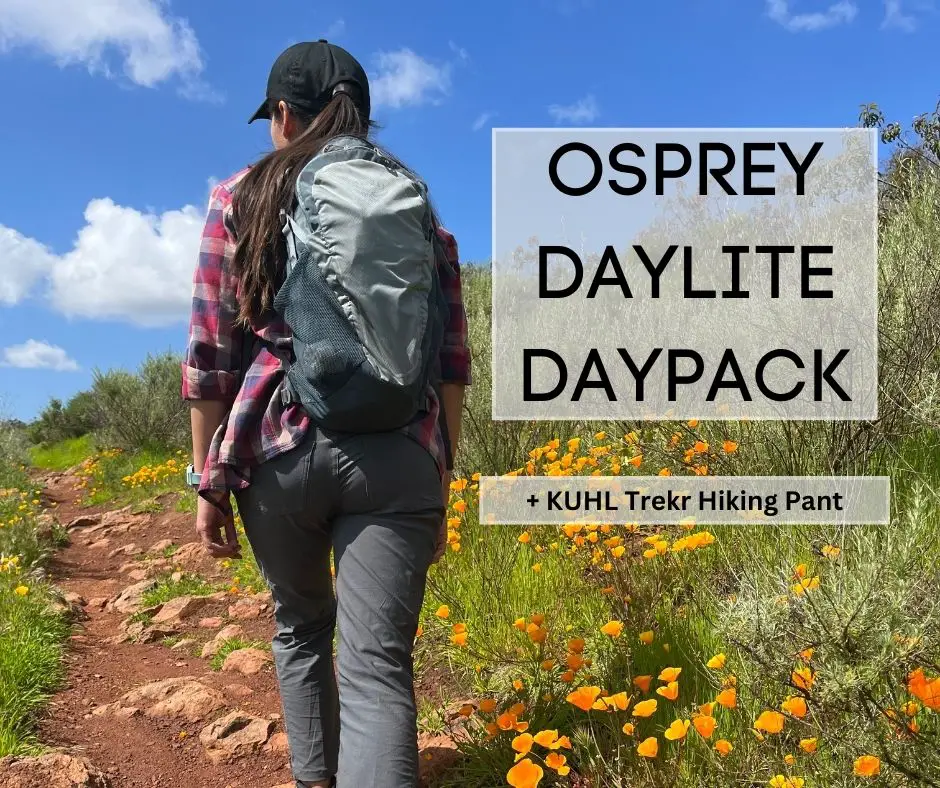
On the majority of my day hikes I use my Osprey DayLite DayPack. It’s perfect for hikes 11 miles or less. There’s a pocket for a hydration bladder. The main compartment is a good size. It fits my snacks/ lunch, a light jacket, first aid, headlamp for sunset hikes, and a light towel. There’s also two mesh side pockets that fit a water bottle, cell phone, or snacks.
Osprey is also really well known in the outdoor community for their quality packs. I always feel confident buying from them because I know their gear will last (unlike my little adidas cinch pack that I used in college).
Hydration Bladder/ Water Reservoir

A hydration bladder/ water reservoir will typically hold more water than a HydroFlask. It’s basically a bag for water. Sizes range from 1 liter to 3 liters. For shorter hikes, a HydroFlask will do. For longer hikes (4+ miles) I would recommend a hydration bladder. They’re lighter than a heavy duty insulated bottle. I use Osprey’s 3 liter Hydration Bladder. They also have a smaller, 2 liter option.
I love the 3 liter version because it’s so easy to fill and clean. Something I didn’t think about with my first water reservoir. My first reservoir was so tricky to fill and nearly impossible to stick a sponge in and clean out.
Hiking Boots/ Shoes for Beginners

Hiking is a much more comfortable activity when your feet are happy. You don’t want to end a hike in pain from blisters or cramped toes. Which is why hiking shoes are on the hiking gear list for beginners.
It’s important that you invest in a quality pair of hiking boots for beginners. So throw out those old running shoes and go to your local REI store. The best way to find the right pair of hiking boots is by trying them on.
Merrell is a popular brand for good reason. They make good hiking boots at an affordable price. The Merrell Moabs are a very popular hiking shoe for beginners. It comes in a mid height as well if you need additional ankle support.
Feel free to also read my take on the Best Hiking Boots under $100.
What To Wear
Always check the weather before you go hiking. A beginner mistake is to check the upcoming weather when you plan to start hiking. The forecasted weather at the time you plan to finish your hike is what you should be dressing for. More often than not it’s going to be a lot warmer when you finish then when you start, especially in the summer.
*If you’re hiking at higher elevations know that the weather can change quickly and layers are going to be your best friend!
Hiking Clothes: Avoid Cotton
The #1 rule is AVOID COTTON. Cotton absorbs moisture. Once the fabric becomes saturated with your body sweat it will no longer provide insulation, like a wet rag. Other moisture wicking fabrics don’t do that. Rather the fibers transfers your sweat/ moisture from your skin to the outer surface of the shirt. Mind blowing, I know. Which is why proper hiking clothes is on the hiking gear list for beginners.
KÜHL is a great privately owned company to get your hiking clothes from. Listen, you get what you pay for. KÜHL makes quality gear and they practice a high standard of business ethics. From their website: “KÜHL will never settle for second best. We source only the finest materials from environmentally conscious and ethically minded partners.”
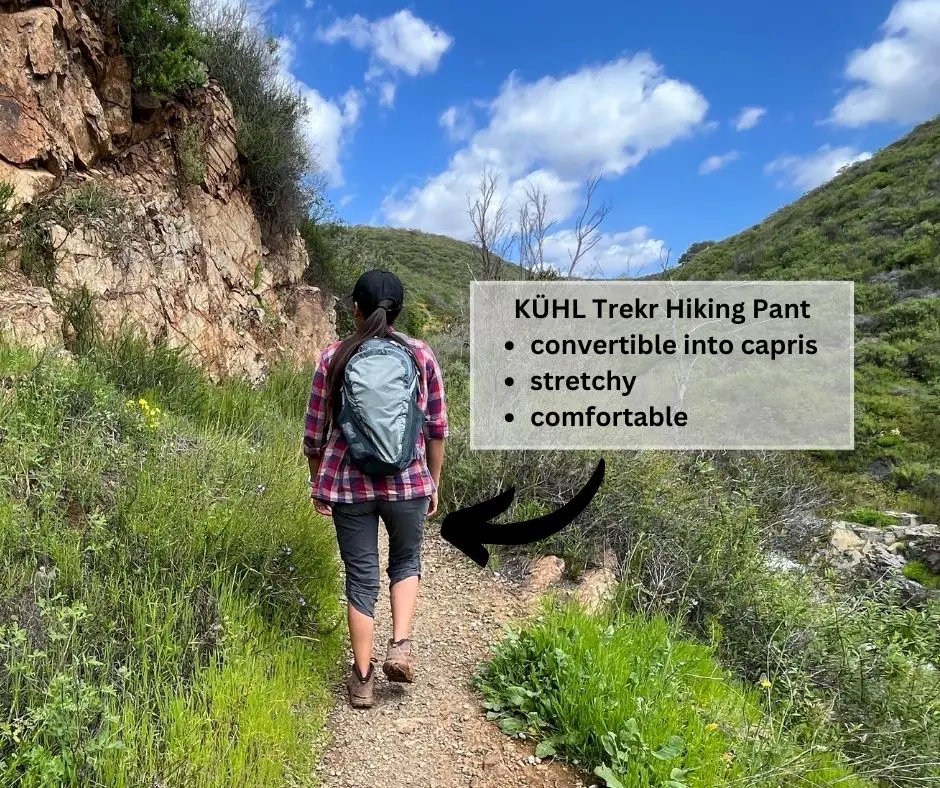
Hiking Socks: Darn Tough

As for hiking socks, I recommend Darn Tough Hiking Socks. As their name suggests, they’re made to withstand a good amount of abuse. They run about $20/ pair but the good thing is you only need one pair of durable hiking socks to get you through beginner hikes.
Hiking Sandals (optional)

Sandals are typically an extra for most hikes. If you know you’ll be hiking through some water (like on Cedar Creek Falls in San Diego)then sandals are a necessity on the hiking gear list for beginners.
If I had sandals when hiking Cedar Creek Falls, then I probably wouldn’t have lost my hiking boot in the San Diego River. We live and learn.
Sunscreen/ Skin Protection

Everyone has their own personal preference for skin products. I like using Sun Bum products because they’re cruelty free and good quality. Badger is another good brand. Their zinc sunscreen stays on my face no matter what activity I’m doing. I alternate between the brands for all my outdoor activities. To each their own!
In Case of an Emergency
You hope you never have to use it, but you’re glad you have the gear if you need it. Here’s what I never go hiking without: first aid, knife, pepper spray, and a lighter. Some first aid kits include an emergency blanket and a whistle. I always add a pair of tweezers to my first aid kit as well. Tweezers are great for pulling out bee stings and thorns. They are a must if you hike with dogs in case you need to get a splinter out of your puppy’s paw.

Some people prefer a multi-tool over a knife since it comes with additional things like a bottle opener and what not. Here’s the knife I always pack: Smith & Wesson Folding Knife.
As for maps, I use AllTrails Premium to download all of my hiking trails in advance. The annual cost is worth the ability to use the maps offline. It’s a no brainer for me. For longer hikes I also pack a portable charger for my cell phone.
Personal Items and Food/ Snacks
The must haves:
- ID, phone, & wallet
- Medication
- Toilet Paper/ wet wipes
- Menstruation products
- Trash bag
- Snacks
For a trash bag, I use my dog’s waste bags. They’re perfect for things like toilet paper, orange peels, granola bar wrappers, etc. Typically if you’re hiking in an urban area, there will be dog waste posts at the beginning of the trail head. You can always snag a bag from there.
Pack whatever snacks you know you’ll eat on the trail. You want to pack food/ snacks you’ll enjoy while hiking. Your food is fuel for your body- make it good.
An alternative option to toilet paper is a reusable antimicrobial pee cloth. Kula is a popular brand amongst backpackers. Check out the Amazon alternative below.

Affiliate disclosure: Go Hiking San Diego is is a participant in the Amazon Services LLC Associates Program. All Amazon links are affiliate links. We only link to products/ services we use or trust. Money earned from qualifying purchases goes to keeping the lights on around here.
